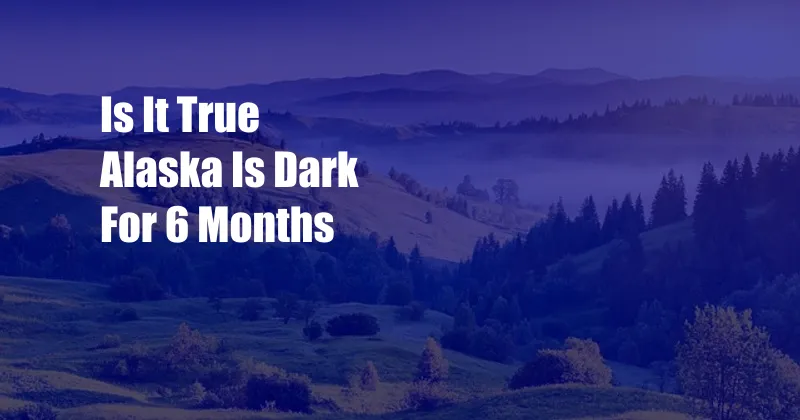
Alaska: Unraveling the Land of Midnight Sun and Polar Nights
The name “Alaska” immediately conjures images of a vast, untamed wilderness, where nature reigns supreme. But a common misconception about this enigmatic state is the notion that it experiences six months of complete darkness during winter. While it’s true that Alaska’s northernmost regions witness extended periods of darkness, the claim that the entire state is shrouded in perpetual twilight is a myth.
Polar Nights and the Arctic Circle
The Arctic Circle, an imaginary line of latitude at 66.56 degrees north, plays a pivotal role in explaining Alaska’s unique light patterns. During winter, areas north of the Arctic Circle, including parts of Alaska, experience a phenomenon known as polar nights. During this time, the sun never rises above the horizon, resulting in an extended period of darkness that can last for several weeks or even months.
The Sun’s Seasonal Dance and Daylight Hours
Alaska might not be completely dark for six months, but its daylight hours during winter are significantly shorter than those in the lower 48 states. In the northernmost parts of Alaska, daylight can be reduced to as little as four hours per day. However, as winter progresses, the days gradually lengthen, and by early spring, Alaska experiences a burst of daylight that lasts well into the evening hours.
The Enduring Twilight and Northern Lights
Even during the darkest months, Alaska experiences a period of twilight known as “civil twilight.” During this time, the sun is below the horizon but provides enough light to allow for outdoor activities without artificial illumination. Additionally, Alaska is famous for its spectacular display of the Northern Lights, or aurora borealis. These ethereal lights, caused by the interaction between solar particles and the Earth’s magnetic field, paint the night sky with vibrant hues of green, purple, and pink.
Adapting to the Seasonal Changes
For Alaskans, the changing daylight hours have become an integral part of life. During winter, they embrace the cozy atmosphere and indulge in indoor activities such as reading, knitting, or gathering around a warm fire. As spring approaches, they revel in the return of sunlight and take full advantage of the extended daylight hours for outdoor adventures.
Expert Advice for Navigating Alaska’s Winter
-
Plan Your Activities: During winter, it’s crucial to adjust your schedule to the shorter daylight hours. Plan activities accordingly and consider using headlamps or flashlights for outdoor excursions.
-
Embrace the Darkness: Don’t let the lack of sunlight dampen your spirits. Take advantage of the longer “civil twilight” hours to enjoy the unique beauty of winter landscapes or witness the Northern Lights.
-
Prepare for Weather Conditions: Alaska’s winters can be harsh, so it’s essential to wear proper clothing, stay hydrated, and be aware of weather forecasts.
FAQs on Alaska’s Daylight Hours
Q: Does all of Alaska experience six months of darkness?
A: No, only regions north of the Arctic Circle experience polar nights, where the sun remains below the horizon for extended periods.
Q: What is civil twilight?
A: Civil twilight occurs when the sun is below the horizon but provides sufficient light for outdoor activities without artificial illumination.
Q: Can you see the Northern Lights during polar nights?
A: Yes, the Northern Lights are often more visible during polar nights due to the darkness and absence of light pollution.
Q: How do Alaskans cope with the short daylight hours?
A: Alaskans adapt to the changing daylight hours by adjusting their schedules, embracing indoor activities during winter, and taking advantage of the extended daylight hours in spring.
Conclusion
The persistent myth of Alaska being dark for six months is just that – a myth. While the northernmost regions of the state do experience polar nights, the majority of Alaska enjoys varying degrees of daylight throughout the year. The seasonal changes in daylight hours provide a unique rhythm of life in Alaska, one where resilience, adaptability, and an appreciation for nature’s wonders prevail. If you’re captivated by the allure of the Land of the Midnight Sun and Polar Nights, embrace the opportunity to witness the enchanting beauty and experience the indomitable spirit of Alaska’s people.